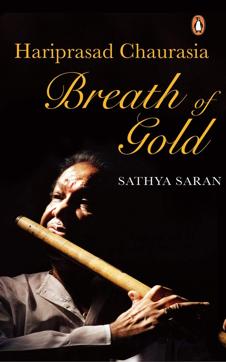Review: Hariprasad Chaurasia; Breath of Gold by Sathya Saran
Sathya Saran’s biography of master flautist Hariprasad Chaurasia provide a detailed account of his immense contribution

Having settled into his job with All India Radio in Cuttack, Orissa, in 1957, flautist Pandit Hariprasad Chaurasia was devastated when he was transferred to Bombay five years later. He decided to give it a shot for a month, and resign if it didn’t work out. As things turned out, Chaurasia became the most sought after flautist in both Hindustani classical and Hindi film music within a short span. From musician to music director to revered guru, his career has had many highs.
Sathya Saran narrates the story of the master flautist with fluency in her biography, Hariprasad Chaurasia: Breath Of Gold. Apart from his musical achievements, through a series of anecdotes, she brings across his warmth, friendliness and sense of humour. Saran’s smooth and engrossing style was evident in her earlier music biographies of ghazal maestro Jagjit Singh and ace composer SD Burman, and here, she effortlessly brings out Chaurasia’s musical personality.
Many followers of Hindustani classical music are aware of the main events of Chaurasia’s life and career, like his upbringing in a wrestler’s family, the early opportunities, his marriage to Anuradha Chaurasia, his learning under surbahar exponent Annapurna Devi, his collaborations and friendship with santoor maestro Pandit Shivkumar Sharma, and his role in imparting bansuri education at his gurukuls in Mumbai and Bhubaneswar, and the conservatory in Rotterdam, the Netherlands. The earlier biographies Woodwinds Of Change by Surjit Singh and Romance Of The Bamboo Reed by Uma Vasudev have covered his contribution elaborately, and Saran quotes widely from the former. These are besides the documentary Romancing The Bansuri by his son Rajeev Chaurasia.
Saran adds to this by blending chronologically phased developments with interludes talking of specific incidents. Sections are devoted to the musician’s upbringing in Allahabad, his days in Cuttack and Bombay, his classical career, film music, international concerts and his role as a guru.
Breath Of Gold is preceded by a Hindi poem by Maya Govind, translated into English by Saran, an introduction by sarod maestro Ustad Amjad Ali Khan, and a prelude by tabla wizard Ustad Zakir Hussain, who describes Chaurasia as one of his mentors, someone who along with Shivkumar Sharma helped him “to decipher and arrive at the understanding of how my tabla playing should be”.
Early chapters talk of how the young Chaurasia fell in love with music. He listened closely to his mother as she sang lullabies. After her death, his father, Chedilal Pehelwan, took care of the three children. Though he was a wrestler, who wanted his two sons to follow in his footsteps, Chedilal could sing bhajans too. The young Chaurasia hid his fascination for the flute, while he looked for a guru.
The world of bansuri was earlier ruled by Pandit Pannalal Ghosh, who died in 1960. When 19-year-old Chaurasia got his AIR job for the then-decent salary of Rs180, his father let him go, thinking he wouldn’t manage living alone in Cuttack and would soon return. As luck would have it, he was the only flautist among violin, sitar, surbahar, sarangi and tabla players at the radio station. He was flooded with work, and the experience gave him confidence.
The book talks at length about Chaurasia’s work in films, beginning with a phone call from Master Sonik, who assisted music director Madan Mohan, asking him to rush to the studio as the original flautist hadn’t arrived. Soon, assignments began pouring in. “Everybody wanted me,” Chaurasia is quoted as saying, referring to top composers of the time.
His association with Shivkumar Sharma in the 1967 album Call Of The Valley, which also features guitarist Brij Bhushan Kabra, is described in detail. So is the association of the Shiv-Hari team with filmmaker Yash Chopra, beginning with Silsila in 1981, where they convinced Amitabh Bachchan to sing.
Read more: Wrestling his way to the world of music
The creation of the famous flute tune in Subhash Ghai’s Hero is recalled, though it is strange that the director claims to have first heard Chaurasia’s music on CDs, a format, which was not released in India before the film’s release in 1983. A few other inaccuracies crop up in the well-structured book. There is a reference to Ustad Hafiz Ali Khan singing, though he was actually a sarod maestro. Annapurna Devi’s building Akash Ganga is on Warden Road, Mumbai, and not Pedder Road as mentioned. The initials of senior HMV officials are wrong – they are VK Dubey (not UK) and GN (not JN) Joshi. Umrao Jaan was released in 1981 and not 1986.
Though readers might not notice these flaws, a little more care would have been in order. Of course, they do not detract from the larger purpose of the book, which is to provide a detailed account of Chaurasia’s magnificent and immense contribution. For classical music fans, this is worth collecting.
Narendra Kusnur is a music critic. He lives in Mumbai.






